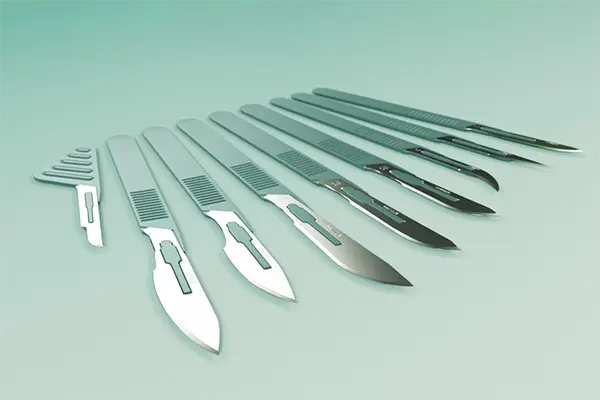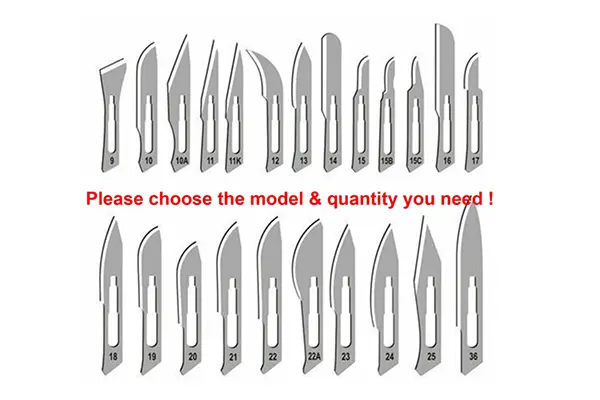Hey there, fellow medical professionals! Welcome to a deep dive into the surgical essentials of the operating room, and today, we’re focusing on a true workhorse: the 15 blade. This article is worth reading because understanding the nuances of this seemingly simple tool can significantly impact the precision and efficiency of your surgical procedure. We’ll explore its uses, features, and how it stacks up against other scalpel blades to help you refine your technique and achieve optimal results. Let’s get started.
1. What is a 15 Blade and Why Does It Matter in Surgery?
The 15 blade is a small, curved surgical blade, a fundamental tool in a surgeon’s arsenal. It’s designed for making precise, controlled incisions in various tissues. Its small blade size and curve allow for detailed work in delicate areas, making it indispensable in many surgical procedures.
The 15 blade is essential because of its precision and control. It’s the blade is ideal for superficial skin incisions and fine dissection. The scalpel provides the surgeon with tactile feedback, enabling a high degree of accuracy and control. The shape allows for easy maneuverability and the creation of precise edges. This directly translates to better surgical outcomes, reduced trauma, and faster healing.
The 15 blade isn’t just a surgical essentials, it’s a symbol of surgical precision. Its correct use is a cornerstone of a surgeon’s skill. It’s one of the surgical instruments that a surgeon will constantly use.
2. Exploring the Anatomy of a Scalpel Blade: Blade Size and Design
The anatomy of a scalpel blade is straightforward yet critical. The 15 blade has a distinctive blade shape: a small, curved cutting edge that terminates in a pointed tip. This blade shape is critical for creating precise incisions, offering the sharpness that is necessary for clean cuts. It is a replaceable blade, as are many other.
The curved cutting edge of the 15 blade is specifically designed for incision, the curve is used to cut. The overall design facilitates controlled movements and minimal tissue trauma. Different blade size and designs cater to diverse surgical needs, but the 15 blade is particularly favored for its versatility.
The 15 blade is generally made of carbon steel or stainless steel, which provides the sharpness and durability needed for surgical procedures. Some scalpel blades also include compositions or coatings for improved performance. The number of blades used in a surgical procedure vary.

3. The Versatility of the 15 Blade: When and How to Use It
The 15 blade is a versatile instrument. Its ability to make precise, controlled incisions makes it ideal for a wide array of applications. Common uses include skin incisions, excisions of small lesions, and creating access points in surgical procedures.
The 15 blade excels in situations where precision is paramount. Think of delicate dissection in dermatological surgery or making precise cuts around a cyst. The small blade size allows the surgeon to make precise cuts in small areas. The 15 blade is used to make both superficial and deeper incisions in a wide range of surgical procedures including dermatological and plastic surgery.
When using a 15 blade, the surgeon will use the "violin grip" or "pencil grip". Proper control is key. Using controlled strokes and applying the right amount of pressure ensures clean, controlled incisions, minimizing trauma. The angle at which the scalpel is held can influence the depth and shape of the incision, so practice is important. This blade is used to make a controlled incision.
4. 15 Blade vs. Other Blades: Choosing the Right Tool for the Job
Understanding how the 15 blade compares to other scalpel blades is crucial for making the right choice. The number of blades available can be confusing, so understanding the blade size and shape is crucial. The 10 blade, for example, is larger and has a more pronounced curve.
The 10 blade is typically employed for longer incisions where greater cutting surface is needed. The 11 blade, with its pointed tip and straight edge, is great for puncture and creating small incisions. Each blade is made to be used for a different part of the process.
The 15 blade is often preferred for superficial skin incisions, fine dissection, and precise work in delicate areas. Surgeons choose the scalpel based on the depth and length of the required incision. 15 blade is ideal for precise incisions. Selecting the right surgical blade is not difficult, and the number of blades needed is determined by the surgical procedure.

5. Follow Us Online: Proper Handling and Safety of the Scalpel
The safe handling of a scalpel is of utmost importance. Accidents with surgical instruments can lead to serious injury, so safety protocols are essential. Always ensure proper lighting and a stable working surface.
When handling the scalpel, always use appropriate techniques for the surgical procedure. Always dispose of the used blade in a sharps container to prevent accidental injury.
The blade is used to make an incision, it’s also important to use appropriate techniques. Be mindful of the environment and the potential for contamination. Follow all hospital protocols for safe surgical practice. Always remember that a scalpel must be used with care.
6. Surgical Essentials: Selecting the Right Scalpel Handle
The scalpel handle is the other half of the equation. It is one of the surgical essentials. It provides the grip and control needed to make the incision. The scalpel handle is a significant part of any surgical instruments.
The scalpel handle is chosen based on the blade size and surgeon’s preference. The most common handle is the number three handle. The surgeon will select the handle and scalpel blade to match the procedure. The number seven handle is another option, particularly for procedures requiring a finer grip.
Ensure the handle and blade are securely connected before starting the procedure. A secure handle and blade is one of the surgical instruments that are key to patient safety.
7. Common Surgical Applications of the 15 Blade – Case Studies
The 15 blade is used in a variety of surgical procedures. Here are some examples:
- Dermatological Surgery: Removing skin lesions, performing biopsies.
- Plastic Surgery: Making precise skin incisions for various procedures.
- Ophthalmology: Fine incision for procedures on the eye.
- Dental Surgery: Used in oral surgery.
In each case, the 15 blade‘s precision allows for controlled excisions and minimal tissue damage, leading to better outcomes. The 15 blade provides precise cuts.
The 15 blade is the ideal choice for dermatologic surgery due to its small size and precision. The 15 blade is the best for dermatologic and plastic procedures. It can be used for creating access points in procedures, and can also be used to remove a cyst.
8. Creogs Over Coffee: Tips and Tricks for Better Incision Control
Even the most skilled surgeons can benefit from refinements in technique. Here are a few tips:
- Grip: Experiment with different grips – "violin grip" or "pencil grip" – to find the one that offers the best control.
- Angle: Adjust the angle of the scalpel based on the desired depth and shape of the incision.
- Pressure: Apply consistent, controlled pressure to ensure a smooth, clean cut.
- Practice: Regular practice is essential for honing your skills with any surgical instrument.
Remember, the aim is to make precise incisions that minimize trauma. The scalpel used requires consistent practice. The surgeon will experiment with the angle to make the precise cuts that are needed. The blade is used to make a variety of cuts.

9. Understanding Number Systems and Blade Nomenclature
Understanding the number systems is crucial for selecting the right scalpel blade. The most common system uses a number to designate the blade size and shape. The number can tell a surgeon which blade is used.
The number 10, 11, and 15 are amongst the most common. Different manufacturers might use slightly different nomenclature, but the general principles remain the same. Understanding these numbers will help you choose the correct blade size. The nomenclature largely remains consistent even with varying surgical instruments.
Know the number and blade size to assist in the surgical procedure. The number of blades used during a procedure are determined by the type of procedure. This will assist with all aspects of the process.
10. Ensuring Quality and Compliance: Sourcing Your Scalpel Blades
When sourcing scalpel blades, quality and compliance are paramount. Ensure your supplier adheres to relevant medical standards such as ISO 13485 and has the necessary certifications.
The 15 blade is a key surgical essentials. Ensure the scalpel blades are sterile (if required) and made from high-quality materials. Check for regulatory compliance with your country’s medical device regulations. Prioritize suppliers with a strong reputation for quality and reliability. The surgical essentials that you need are surgical instruments of top quality.
Remember that you may need to follow specific country regulations. This is especially true when dealing with countries like the USA and Europe. The 15 blade can become part of the surgical essentials when made with quality materials.
Key Takeaways
- The 15 blade is a versatile scalpel blade for precise incisions in various surgical procedures.
- Understand the blade size and design to choose the right tool for the job.
- Practice safe handling and disposal of scalpel blades.
- Select the appropriate scalpel handle for optimal control.
- Choose high-quality, compliant scalpel blades from reputable suppliers.
- Consider the 10 blade, 11 blade or 12 blade as other options.
- Mastering the 15 blade requires practice and attention to detail.
Remember, the 15 blade is more than just a surgical instrument; it’s an extension of your skill and precision. By mastering its use and understanding its nuances, you can enhance your surgical technique and improve patient outcomes.
Medicalzx.com offers a wide range of surgical instruments, including the 15 blade and other surgical essentials. Whether you’re a seasoned surgeon or a resident just starting out, we’re here to provide you with the high-quality medical supplies you need. Contact us today to explore our product offerings, including our Medical Cotton, Cotton Balls, and Swabs, Medical Gauze and Bandages and Surgical Instruments. Follow us online for more insights and updates.
Post time: 2月-13-2025





